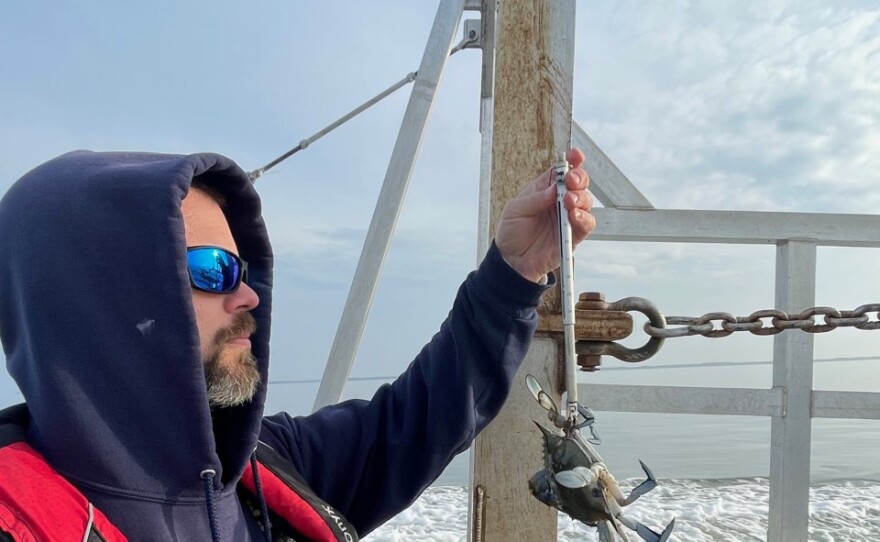Every year about this time, crews from Maryland’s and Virginia’s natural resources departments head out onto the Chesapeake Bay and its tributaries on boats. Workers are dredging the muddy bottom in the water for crabs, not for the steamer, but for research. It’s called the winter dredge survey. State employees use the information they get to develop harvest regulations for commercial crabbers.
Shaun Miller, a biologist with Maryland’s Department of Natural Resources, says they have to do it in the winter because that’s when crabs hibernate, when they “bury themselves in the mud.”
Miller said that winter is ideal because, “this is the only time of the year that they're not mobile,” he explained. “If we tried to do the same thing and get an estimate during the summertime, it'd be impossible.”
Genine McClair, who runs the Maryland Department of Natural Resource’s blue crab program, says the survey is the first of three steps. They use the results to develop a management program and then they do research.
“And that's really just us partnering with academic institutions or other scientists in the region to identify knowledge gaps when it comes to blue crabs and help to fill those knowledge gaps,” McClair said.
On a recent gray January morning, they were working a section of the upper Chesapeake Bay off Rock Hall on the Eastern Shore.
Capt. Roger Morris, a Dorchester County waterman who works under contract with the state’s department of natural resources, dropped a Virginia dredge off the stern of Mydra Ann, his 45-foot Bay workboat, and let the attached chain pay out until the dredge hit bottom 20-some feet below, jolting the boat. A Virginia dredge refers to an eight foot wide piece of equipment with an attached net that gets dropped into the water to dredge for crabs. Morris eased the throttle forward and dragged the dredge through the mud for one minute at three knots, then hauled it back up, pausing to rinse the mud out before bringing it on board.
McClair and John Murphy, Morris’s crewman, flip the net to empty it onto a wide wooden platform and begin sorting on their hands and knees through an array of shells, searching for blue crabs. Nothing.
But it’s only the first stop on a trip that will take them from the Eastern to Western shore, off the mouths of the Patapsco and Magothy rivers and back to Kent Narrows, about 45 miles southeast of Baltimore's Inner Harbor, by the end of the day.
Miller, the biologist, says that’s not unusual for this part of the Bay at this time of year.
“They tend to move more south, and it’s just a general function of the concentration of crabs,” he said. “You know, late in the season they tend to find deeper water and move south to overwinter.”
But for this survey, which Maryland and Virginia have been doing for more than 30 years, they have to sample the whole Bay to get an accurate picture – 750 sites in each state chosen by a random computer program.
Capt. Morris, who has fished crab pots in the summer for more than 40 years, once dredged for crabs in the winter in Virginia waters until that was banned in 2008. It was banned as an environmental conservation measure. Then, he bid on this job. He says it’s a bit easier than the work in Virginia. And he likes it.
“Because everything, our bushel limits, are based on what we catch here in the wintertime,” he said. “And I try to do a good job 'cause it affects me in the summertime on my bushel limits.”
As they reach each sampling site, McClair dumps a bucket of water over the side and scoops up a new one to test for temperature and salinity.
Blue crabs can tolerate a wide range of salinity, from ocean water to almost fresh, she said. But crabs are more sensitive to temperature.
“Sustained water temperature below four degrees Celsius gets very stressful on them when they're in their hibernation state,” she explained. “Overwintering mortality really kind of depends on the size of the crab, the sex of the crab. It varies, depending on their life stage and their gender.”
By the time they reach Six Mile Knoll, once a prime oystering ground off Sparrows Point, they’ve caught crabs – some ready for the steamer, others barely the size of a fingernail – across several sites.
Here, the net is full of old oyster shells and Murphy and McClair dump the net and begin sorting.
For the third time in a row, they find crabs. Miller measures and weighs them, checks their sex and carefully records the data before tossing them back.
They will have sampled more than 30 sites by late afternoon before Morris threads Mydra Ann back through the channel markers to the state-owned Department of Natural Resources slip on Kent Narrows.
Miller said they found more crabs on this trip than they expected, but they’re not making any predictions until they’ve sampled all the way to Tangier Sound and the Virginia line.

















